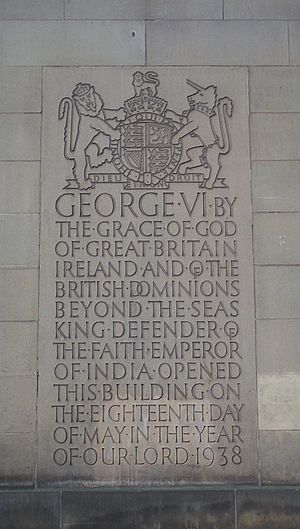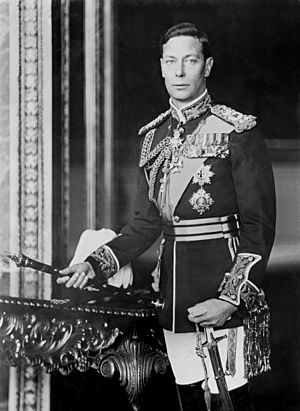List of titles and honours of George VI facts for kids
King George VI was a very important person in British history. He was born on December 14, 1895, and passed away on February 6, 1952. During his life, and especially when he was King of the United Kingdom, he received many special awards, titles, and military ranks. This article will tell you about some of the important honours he held.
Contents
Titles and Special Names

Quick facts for kids Styles ofKing George VI |
|
|---|---|
 |
|
| Reference style | His Majesty |
| Spoken style | Your Majesty |
From the moment he was born, George VI was a Prince of the United Kingdom. Later, he was given the special title of a royal duke. He became King after his brother, King Edward VIII, stepped down from the throne.
Here are some of the titles he held during his life:
- 14 December 1895 – 28 May 1898: His Highness Prince Albert of York
- 28 May 1898 – 22 January 1901: His Royal Highness Prince Albert of York
- 22 January 1901 – 9 November 1901: His Royal Highness Prince Albert of Cornwall and York
- 9 November 1901 – 6 May 1910: His Royal Highness Prince Albert of Wales
- 6 May 1910 – 3 June 1920: His Royal Highness The Prince Albert
- 3 June 1920 – 11 December 1936: His Royal Highness The Duke of York
- He also held smaller titles like Earl of Inverness and Baron Killarney.
- 11 December 1936 – 6 February 1952: His Majesty The King
Titles as King
As the King, George VI held certain important titles that came with the Crown.
Lord of Mann
 From 11 December 1936 to 6 February 1952, he was known as His Majesty The King, Lord of Mann. This title is for the ruler of the Isle of Man.
From 11 December 1936 to 6 February 1952, he was known as His Majesty The King, Lord of Mann. This title is for the ruler of the Isle of Man.
Head of the Church of England
 From 11 December 1936 to 6 February 1952, he was the Defender of the Faith and Supreme Governor of the Church of England. This means he was the official head of the Church in England.
From 11 December 1936 to 6 February 1952, he was the Defender of the Faith and Supreme Governor of the Church of England. This means he was the official head of the Church in England.
Other traditional titles for the King include Duke of Lancaster. This title shows that the Duchy of Lancaster is a private estate belonging to the King. He was also called Duke of Normandy because he was the head of state for the Bailiwicks of Jersey and Guernsey.
Personal Titles
George VI also held some titles just for himself, either because he was born with them or they were given to him.
House of Saxe-Coburg and Gotha
 From 14 December 1895 to 17 July 1917, he was a Prince of Saxe-Coburg and Gotha and Duke of Saxony. This was a German royal family title.
From 14 December 1895 to 17 July 1917, he was a Prince of Saxe-Coburg and Gotha and Duke of Saxony. This was a German royal family title.
Head of the Commonwealth
- From late April 1949 to 6 February 1952, he was the Head of the Commonwealth. This is a group of countries that used to be part of the British Empire.
King in Other Countries
The Dominions were countries that governed themselves but still had the British King as their head of state. These countries used the same titles for the King as the United Kingdom. For example, the King was called "King of the British Dominions beyond the Seas." This showed he ruled over these self-governing nations.
After 1947, India became independent. King George VI stopped being the "Emperor of India" in 1948. However, he continued to be King of the newly formed countries of India and Pakistan for a short time.
Military Ranks
King George VI held many important military ranks in the United Kingdom and other countries. He started his military career in the Royal Navy.
United Kingdom Military Ranks
 15 May 1916 – 1918: Sub-Lieutenant, Royal Navy (a junior officer in the navy)
15 May 1916 – 1918: Sub-Lieutenant, Royal Navy (a junior officer in the navy)- 29 December 1918 – 1919: Temporary Captain and Staff Officer (3rd Class, Air), Royal Air Force (an officer in the air force)
- 3 June 1919: Personal Aide-de-Camp to the King (a special assistant to the King)
- 1 August – 1 November 1919: Flight Lieutenant, Royal Air Force
- 1 November 1919 – 1 June 1920: Squadron Leader, Royal Air Force
- 31 December 1920 – 1925: Commander, Royal Navy (a senior officer in the navy)
- 1 June 1920 – 30 June 1921: Wing Commander, Royal Air Force
- 30 June 1921 – 3 June 1932: Group Captain, Royal Air Force
- 3 June 1932 – 1 January 1936: Rear-Admiral, Royal Navy (a high-ranking navy officer)
- 3 June 1932 – 1 January 1936: Major-General, British Army (a high-ranking army officer)
- 3 June 1932 – 1 January 1936: Air Vice-Marshal, Royal Air Force (a high-ranking air force officer)
- 11 December 1936 – 6 February 1952: Admiral of the Fleet, Royal Navy (the highest rank in the navy)
- 11 December 1936 – 6 February 1952: Marshal of the Royal Air Force (the highest rank in the air force)
- 11 December 1936 – 6 February 1952: Field Marshal, British Army (the highest rank in the army)
Australian Military Ranks
 2 June 1938 – 6 February 1952: Admiral of the Fleet, Royal Australian Navy
2 June 1938 – 6 February 1952: Admiral of the Fleet, Royal Australian Navy- 2 June 1938 – 6 February 1952: Marshal of the Royal Australian Air Force
- 2 June 1938 – 6 February 1952: Field Marshal, Australian Army
Awards from Other Countries
King George VI also received many special awards and honours from other countries around the world. These awards are often given to important leaders to show friendship and respect.
| Country | Date | Award | Short Name |
|---|---|---|---|
| 5 June 1917 – 14 September 1917 | Knight 4th Class with Swords of the Imperial Order of Saint Prince Vladimir | ||
| 11 August 1917 – 2 June 1946 | Knight of the Military Order of Savoy | ||
| 1918 – 2 December 1945 | Grand Cross of the Royal Order of the White Eagle | ||
| 1919 – 6 February 1952 | Grand Cross of the National Order of the Legion of Honour | ||
| 30 November 1920 – 6 February 1952 | Knight of the Order of the Elephant | RE | |
| 18 October 1922 – 10 September 1944 | Grand Cross with Collar of the Order of Carol I | ||
| 26 April 1923 – 6 February 1952 | Grand Cross with Collar of the Royal Norwegian Order of Saint Olav | StkStOO m kjede | |
| 10 May 1937 – 6 February 1952 | Knight of the Royal Order of the Seraphim | RSerafO | |
| 2 February 1938 – 6 February 1952 | Knight of the Most Illustrious Order of the Royal House of Chakri | MCK | |
| 2 May 1939 – 6 February 1952 | Grand Cross of the Riband of the Three Military Orders | BTO | |
| 19 July 1939 – 2 December 1945 | Grand Cross of the Order of the Star of Karađorđe | ||
| 1 July 1946 – 6 February 1952 | Grand Cross of the Military William Order | MWO | |
| 13 November 1947 – 6 February 1952 | Grand Cross of the Order of Saint-Charles | ||
| 8 May 1951 – 6 February 1952 | Grand Commander of the Order of the Dannebrog | SKmd | |
| 2 April 1960 (after his death) | Member of the Ordre de la Libération |
Freedom of the City Awards
The "Freedom of the City" is a special honour given by a city to a respected person. It means they are welcomed and honoured by the city. King George VI received this honour from several cities.
Cities in the Commonwealth
 28 October 1919: London.
28 October 1919: London. 1924: Derry.
1924: Derry. 26 October 1926: Glasgow.
26 October 1926: Glasgow. 29 August 1928: Stirling.
29 August 1928: Stirling. 1929: Ilford.
1929: Ilford. 10 August 1935: Perth.
10 August 1935: Perth.
Things Named After King George VI
Many places, roads, and buildings are named after King George VI to remember him.
These include:
- King George Hospital in London.
- King George VI Reservoir in Surrey, United Kingdom (a large water storage area).
- King George Highway and King George Boulevard in Surrey, British Columbia, Canada (roads).
- Kingsway in Edmonton, Canada (a road).
- George VI Sound in Antarctica (a body of water).
- The King George VI Chase, a famous horse race in the United Kingdom.
A future Dreadnought-class submarine for the Royal Navy will also be named HMS King George VI.
See also
- Style of the British Sovereign
- Title and style of the Canadian monarch
- List of titles and honours of Queen Elizabeth The Queen Mother
- List of titles and honours of Elizabeth II
- List of titles and honours of Prince Philip, Duke of Edinburgh
- List of titles and honours of George V
- List of titles and honours of Mary of Teck
- List of titles and honours of Charles III
- List of titles and honours of Queen Camilla
- List of titles and honours of William, Prince of Wales
- List of titles and honours of Catherine, Princess of Wales
- List of titles and honours of Anne, Princess Royal
- List of titles and honours of Prince Arthur, Duke of Connaught and Strathearn
- List of honours of the British royal family by country


